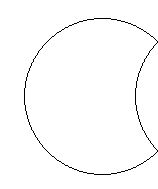Question 197775: Consider the formula n(A U B) = n(A) + n(B) - n(A ∩ B).
(a) Show that this relation holds for A = {1, 2, 3, 4} and B= {2, 4, 5, 6, 7, 8}
(b) Make up your own two sets A and B, each consisting of at least six elements. Using these two sets, show that the relationship above holds.
(c ) Use a Venn diagram and explain why the relation holds for any two sets A and B.
Answer by Edwin McCravy(20055)   (Show Source): (Show Source):
You can put this solution on YOUR website! Consider the formula n(A U B) = n(A) + n(B) - n(A ∩ B).
(a) Show that this relation holds for A = {1, 2, 3, 4} and B= {2, 4, 5, 6, 7, 8}
A has 4 elements, so n(A)=4
B has 6 elements, so n(B)=6
A U B = all elements which are in either A or B or both =
{1,2,3,4,5,6,7,8)
A U B has 8 elements so n(A U B) = 8
A ∩ B = all elements which A and B have in common = {2,4}
A ∩ B has 2 elements, so n(A ∩ B) = 2
n(A U B) = n(A) + n(B) - n(A ∩ B).
8 = 4 + 6 - 2
8 = 10 - 2
8 = 8
So it's true.
(b) Make up your own two sets A and B, each consisting
of at least six elements. Using these two sets, show
that the relationship above holds.
I'll let you do that one by yourself
(c ) Use a Venn diagram and explain why the relation
holds for any two sets A and B.
 The set (circle) A consists of two parts:
The set (circle) A consists of two parts:
 and this part and this part The set (circle) B consists of two parts:
The set (circle) B consists of two parts:
 and this part and this part Now this part
Now this part  is common to both sets, so it's A ∩ B
So if we add the number of elements in A to the number
of elements in B, we would have this
n(A) + n(B) is common to both sets, so it's A ∩ B
So if we add the number of elements in A to the number
of elements in B, we would have this
n(A) + n(B)
 + +  + +  + +  But as we see, this amounts to adding this part
But as we see, this amounts to adding this part  TWICE!!! This part that we have added twice is A ∩ B.
But we only want to add it ONCE, not TWICE!!!,
So we must subtract the number of elements in A ∩ B ONCE, so
it will not be added TWICE, but only ONCE
So we subtract it from n(A)+n(B), and we get
n(A)+n(B)-n(A ∩ B)
and we have this:
TWICE!!! This part that we have added twice is A ∩ B.
But we only want to add it ONCE, not TWICE!!!,
So we must subtract the number of elements in A ∩ B ONCE, so
it will not be added TWICE, but only ONCE
So we subtract it from n(A)+n(B), and we get
n(A)+n(B)-n(A ∩ B)
and we have this:
 + +  + +  + +  - -  And the set A ∩ B that we subtracted away, cancels with
the extra A ∩ B,
And the set A ∩ B that we subtracted away, cancels with
the extra A ∩ B,
 + +  + +  + +  - -  and we are left with this:
and we are left with this:
 + +  + +  which, when we put them back together is this:
which, when we put them back together is this:
 which is n(A U B). That's why the formula works
n(A U B) = n(A) + n(B) - n(A ∩ B),
the n(A ∩ B) gets counted once as part of n(A),
and gets counted again in part of n(B), when we add n(A) + n(B),
and so n(A ∩ B) must be subtracted once to take
away the extra time it is counted.
Edwin
which is n(A U B). That's why the formula works
n(A U B) = n(A) + n(B) - n(A ∩ B),
the n(A ∩ B) gets counted once as part of n(A),
and gets counted again in part of n(B), when we add n(A) + n(B),
and so n(A ∩ B) must be subtracted once to take
away the extra time it is counted.
Edwin
|
|
|